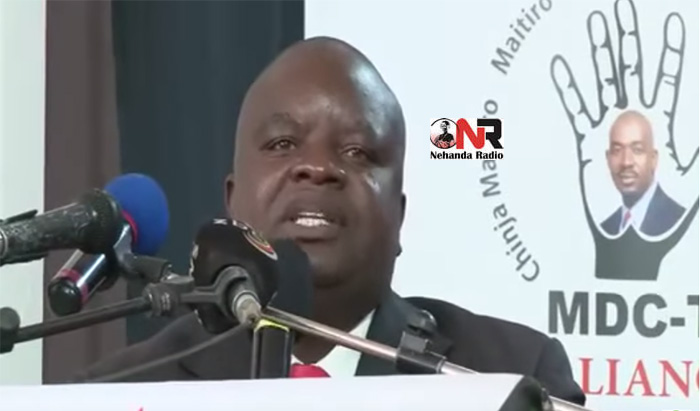By Dr Tapiwa Mashakada
Many people think that the MDC was formed in 1999. This is not correct. So my starting point is to recall the role played by the labour movement, the Constitutional and Student Movements in the birth of the MDC. I start with the role played by the Labour Movement.

At independence in 1980 labour was organized along racial lines. White artisans had their own unions while blue collar workers formed theirs. Mugabe’s government took the position that a strong labour federation would effectively represent workers and champion their causes.
Kumbirai Kangai was the first black Minister of Labour. So in 1981 government facilitated the formation Zimbabwe Congress of Trade Unions (ZCTU) as the umbrella body of trade unions in Zimbabwe thereby abolishing the colonial dual system.
However it meant that the labour movement became a poodle of government. Government imposed Albert Mugabe as the Secretary General followed by Ishmael Nedziwe until the 1988 Congress in Gweru which Morgan Tsvangirai was elected as the ZCTU Secretary General.
Tsvangirai came from the Mine Workers Union. Previously he had worked at Trojan Mine in Bindura. MT transformed the ZCTU and institutionalized it.
He opened offices at Pockets Building along Jason Moyo Avenue. At first ZCTU had 2 departments ie Education and Organizing departments with a skeletal staff comprised of Dr Godfrey Kanyenze, sisi Viola, Sekuru Giriya and Chirebvu the book keeper. Later on Edith Munyaka joined as MT’s Secretary.
MT set the ZCTU apart and cut the umbilical cord with government. Later on ZCTU established the Health and Safety Department headed by Dr Rene Loewensen and Isaac Mudyandaruva, The Economics Dept was started by Dr Godfrey Kanyenze who was joined later by David Mutsvangwa and Dr Tapiwa Mashakada.
The Women’s Department was head by amai Miriro Pswarayi and Kondo headed the Education department and later the Advocacy department and was joined by Makonese. James Makore headed the Organizing Department during this crucial period.
During this period ZCTU followed the Marxist-Leninist doctrine so we used to address ourselves as comrades and we worked closely with Communist countries such as the Soviet Union, Bulgaria, Hungary, Czechoslovakia, Poland, Romania, GDR (east Germany). To show this link ZCTU received material to build a labour college from Romania under Nicolae Ceausescu.
In1988 MT had a baptism of fire. He had issued a statement condemning govt for its heavy handedness when it used brutal force to crush the UZ student demos led by Arthur Mutambara, Tendai Biti and Munyaradzi Gwisai. MT was abducted and taken to Goromonzi police station.
He stayed there for a month. He was only released after the intervention of Mike Bimha the former Minister of Industry and Trade. During this same period Gibson Sibanda from the Railways Workers Union became the ZCTU President and they made a wonderful combination with MT.
ZCTU went on a collision course with government by criticising policies and laws that hurt workers. In 1992 ZCTU embarked on a strike against amendments to the Labour Relations Act. The strike was declared illegal. Tendai Biti represented the Labour Centre in all court challenges.
Fast forward in 1997 ZCTU organized a Mass Action and the whole country was shutdown with looting in Mabvuku and Chitungwiza. Between 1991 and 1996 ZCTU opposed the economic structural adjustment Program (ESAP) which led to retrenchments and cut back in social spending.
The ZCTU became a force to reckon with. Mugabe’s response was to challenge the ZCTU to form a political party instead of using workers to expose government. In 1998 the ZCTU started a country wide consultation gathering raw data on the way forward in view of government intransigence.
Dennis Murira, Ghandi Mudzingwa, Timothy Kondo, James Makore, Esaph Mdlongwa, David muzhuzhu, Last, Nomore Sibanda and others were in charge of the raw data. In the process they engaged a rural women’s organization called Orap which was led by Sithembiso Nyoni who is the current government Minister responsible for SMEs.
The result of the raw data was the National Working Peoples Convention of Feb 1999 which took place at the Women’s Bureau in Hillside. The Convention to discuss the socio-economic crisis. I must conclude this part by acknowledging the roles played by trade union activists, students and academics during these formative years.
These included Nicholas Mudzengerere, Paurina Mpariwa, Thokozani Khupe, Gregory Peta, Gift Chibatwa, Japhet Moyo, Cephas Makuyana, Mago, Chimombe, Morgen Komichi, Gwiyo, Shambare, Chibebe, Ngirandi, Gwenzi, Chifamba, Mlambo, Amos chibaya, Lucia Matibenga, Margaret Matienga, Milton Gwethu, Musokeri, Gwayagwaya, Remus Makuvaza, Isaac Matongo, Khumalo(mdc chair) lovemore matombo, Tichaona Chiminya, Peter Moyo Mutengwa,Mushayabasa and other trade union activists too numerous to mention.
Academics such as Prof Lloyd Sachikonye, Kempton Makamure, Shephered Nzombe, Shadreck Guto, and Manase. Students who need to be mentioned include Arthur Mutambara, Munyaradzi Gwisa , Nelson Chamisa, Tafadzwa Musekiwa, Learnmore Jongwe, Job Sikhala, Daniel Molokele, Giwa, Mbwembwe, Madhuku, Chalton Hwende, Gabriel Chaibva, Brian Kagoro and others.
Civil Society played a pivotal role in the formation of the MDC. Sekai Holland and her Association of Women’s Clubs were key. The Association of Independent Candidates led by Fidelis George Mhashu and included Chimbaira and Priscilla Misihairabwi also contributed a lot in the ZCTU efforts.
Part 2 will look at the role of Students and NCA up to the National Working Peoples Convention.
Comments are most welcome. PLEASE NOTE THAT THIS IS JUST A FIRST DRAFT OF the MDC HISTORY PROJECT. I NEED TO BE CORRECTED NOT ATTACKED. I MAY HAVE OMITTED NAMES OF OTHER STALWARTS BY MISTAKE AND I WANT THOSE ADDITIONS. Thank You.






